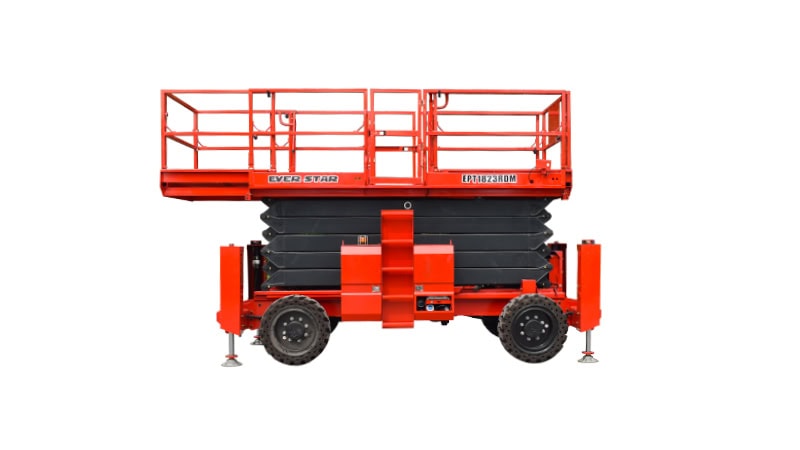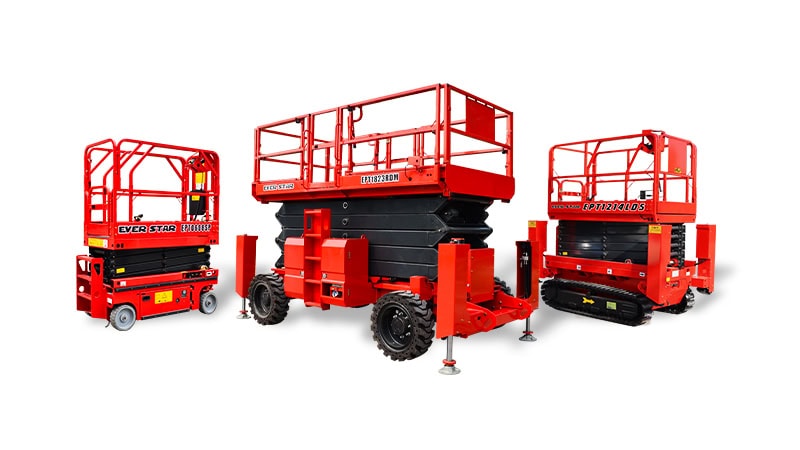
Key Takeaways
- Many scissor lift models feature automatic leveling outriggers that enhance security by stabilizing the machine on slopes and uneven surfaces.
- Features such as outriggers, powerful engines, and self-leveling mechanisms ensure safe operation on irregular terrain.
- High platform capacity and extended working height improve productivity in demanding outdoor settings.
- Lift capacity and platform height are key measurements for evaluating the machine’s vertical reach; different models offer varying heights to suit specific elevated tasks.
- Proper maintenance and selecting the appropriate machine type significantly influence safety, return on investment, and jobsite success.
Rough-terrain scissor lifts are vital equipment for off-road and construction tasks, providing access to elevated work areas that standard lifts cannot safely achieve. Unlike conventional lift models, these scissor lifts are designed to handle the toughest conditions—from rocky terrain to muddy fields.
Choosing the right equipment is crucial for ensuring safety, protecting operators, and optimizing operational efficiency when working at height on uneven ground.
This article delves into the design elements, safety features, machine’s capacity, and practical advantages that make Everstar’s scissor lifts the top choice for challenging environments.
Why Heavy Duty Scissor Lift Stability is Crucial on Uneven Ground
Uneven jobsite terrain creates significant hazards for elevated work, such as platform instability, machine tipping, slipping, and potential accidents. Operating a scissor lift on irregular surfaces—such as hillsides or gravel lots—requires careful attention to the platform size, lift capacity, balance, gradeability, and safety.
An elevated work platform, such as a scissor lift, provides a stable, level platform that can reach heights up to 60 ft. Since many tasks involve working at elevation or in tight spaces, instability can cause equipment failure and injuries.
Engineering Innovations for Stability
Everstar Machinery prioritizes stability through intelligent weight distribution, reinforced chassis, and advanced axle designs in its elevated work machines. Durable, deep-tread, and non-marking tires combined with four-wheel drive deliver excellent traction on muddy, rocky, or sloped terrains.
The off-road series two-way fold-out platform scissor lift also includes outriggers and leveling systems, such as automated hydraulic legs, which provide extra support when extended. This keeps the platform steady and secure at heights up to 60 ft, even when carrying heavy loads and multiple tools.
Platform height is a key specification that indicates the maximum vertical reach of the lift platform, making it an important factor to consider when selecting a model for tasks in elevated or narrow locations.
These models are engineered to withstand harsh environments while maintaining high performance for applications such as tree care, large billboard installation, debris cleanup on construction sites, and outdoor event setup.
Key Features of Scissor Lifts for Rugged Terrains
Rough terrain scissor lifts differ from standard models in durability and operational capability. They offer higher floor clearance, reinforced steel frames, and superior maneuverability and capacity across all terrain types.
Typically powered by fuel engines, these machines deliver increased torque and reliable performance during extended outdoor shifts—essential for continuous use. Modern lifts commonly support 800–1,400 lbs, with platform height—a key measurement indicating the maximum vertical capacity of the lift platform—ranging from 40 ft to over 60 ft.
This specification is crucial for comparing different models and ensures suitability for major construction and utility projects at significant elevations.
The Importance of Outriggers and Leveling Systems
Outriggers and automatic leveling are hallmark features of rough terrain scissor lifts. Designed for structural work, general contracting, and maintenance across diverse sites, outriggers extend hydraulic legs at each corner to stabilize the machine by counterbalancing weight and keeping the platform level on uneven or sloped ground.
With a crisscrossing (scissor-like) support system that raises the equipment vertically and built-in sensors that detect tilt and make real-time adjustments, it ensures operators and materials stay secure during maximum elevation work while reducing downtime caused by instability.
This technology is a key reason rough terrain scissor lifts lead the all-ground scissor class in safety-critical environments.
Productivity and Versatility in Tough Conditions

Rough terrain scissor lifts boost productivity by enabling access to previously unreachable outdoor sites for construction, utilities, and repair work. Their power, platform size, and stability systems enable workers to transport materials and tools to elevated, remote locations efficiently.
Industries such as oil and gas, telecommunications, stadium maintenance, and renewable energy rely on these lifts capacities for their durability and versatile all-terrain requirements.
Operating on soft soil, rocky surfaces, or slopes, these mobile platforms maximize uptime and reduce costly delays. They accommodate multiple workers and materials, achieving heights up to 60 ft tailored to project needs.
The platform height of each model determines the maximum elevation workers can safely access, making it a critical factor for project planning. Rough terrain scissor lifts deliver measurable ROI in challenging outdoor environments.
Operator Experience and Safety
Modern operator cabins in scissor lifts feature intuitive controls, ergonomic seating, and excellent visibility for safe maneuvering on construction sites. Safety remains paramount, with platform guardrails, non-slip floors, motion alarms, and tilt sensors protecting operators.
Advanced control systems and redundant safety features help operators achieve precise vertical and horizontal movements, even when fully elevated, in narrow locations or carrying heavy loads.
Selecting the Right Lift Capacities
Choosing the right scissor lift starts with understanding your job site’s specific challenges and project requirements. Assess platform size, capacity, and elevation needs, including platform height as a primary measurement of the lift’s vertical reach, and determine if outriggers or additional stabilization are necessary for ground conditions.
When considering rough terrain scissor lifts, carefully review the terms depending on project length, as these items affect total cost and flexibility. Knowing these details is vital for selecting the best equipment.
Different scissor series offer engines optimized for heavy-duty use and long lifespan, along with maintenance plans to reduce downtime.
Comparing Models: Finding the Best Fit to Yout Project
When evaluating Everstar’s scissor lift series, review technical specs such as platform capacity for personnel and materials, maximum working height (ft), engine type and power, floor clearance, tire size, gradeability, and platform height, which indicates the platform’s maximum vertical capacities.
Outriggers are crucial for work on steep slopes or where maximum height is needed. Rough terrain scissor lifts equipped with outriggers provide an extra layer of safety, often making them the ideal choice for demanding environments.
Check out the aerial work platforms’ technical specifications here:
| Unit Name | Key Feature(s) | Load Capacity | Working Height | Climbing Angle |
|---|---|---|---|---|
| Track Series Mobile Scissor Lift | Tracks for rugged terrain, reinforced outriggers. | 441–992 lbs (200–450 kg) | 19.7–59.1 ft (6–18 m) | 25° / 30° |
| Wheeled Series Mobile Scissor Lift | Compact wheels, pothole protection, electric drive, and silent operation. | 507–992 lbs (230–450 kg) | 19.7–59.1 ft (6–18 m) | 25° |
| Off-Road Series Two-Way Unfolding | Two-way expansion platform, integrated axle. | 805–1499 lbs (365–680 kg) | 45.9–59.1 ft (14–18 m) | 35° / 40° |
FAQs – Off-road Scissor Series
Can a scissor lift be used on uneven ground?
Yes, rough terrain scissor lifts are specifically designed to operate safely on uneven surfaces, featuring outriggers, self-leveling systems, and enhanced traction tires to maintain stability and safety during elevation.
What is a rough-terrain scissor lift?
A rough-terrain scissor lift is a heavy-duty, off-road model designed to navigate and work safely on rugged terrain. It comes equipped with powerful engines, non-marking tires, and stability systems suited for construction, utility, and industrial job sites.
How much weight can a rough-terrain scissor lift hold?
These lifts typically support platform loads from 800 lbs to 1,400 lbs, depending on model. This capacity allows operators to safely bring tools, materials, and personnel to heights between 40 ft and 60 ft.
Do scissor lifts have outriggers?
Many rough terrain scissor lifts include outriggers or leveling systems. These features enhance stability and safety on uneven or sloped sites, making them essential for outdoor elevated work.
Conclusion: Enhancing Project Efficiency with the Right Scissor Lift

Rough terrain scissor lifts provide unmatched advantages for working on uneven ground, including exceptional platform stability, reliable height capabilities, powerful engines, and productivity-boosting tools.
Selecting the right model and properly maintaining it ensures safety, efficiency, and a solid return on investment. Matching your scissor lift unit choice to your project’s conditions is key to safe, successful elevated work.
Contact Everstar Machinery
For expert advice and tailored equipment recommendations, reach out to Everstar Machinery specialists. Whether you want to discuss platform heights, engine options, or the best tools for your job site, our team is ready to help you find the perfect off-road scissor lift to add value to your project.
Browse the Everstar catalog or get in touch today to maximize safety, productivity, and value with every scissor lift.